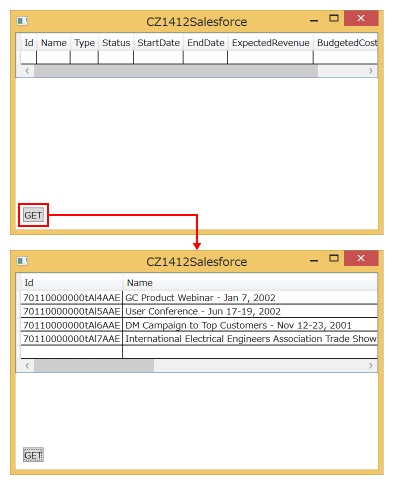コードからEFを利用する
準備が完了したので、SalesforceContextを使ってデータを取得するModelクラスを作成します。
Imports System.Collections.ObjectModel
Imports System.ComponentModel
Imports System.Runtime.CompilerServices
Namespace Models
Public Class SalesForceModel
Implements INotifyPropertyChanged
Public Property Items As New ObservableCollection(Of Campaign)
Public Sub GetCampaign()
Dim ents = New SalesforceContext()
Dim campaignQuery = From item In ents.Campaign Order By item.Id Select item
Me.Items = New ObservableCollection(Of Campaign)(campaignQuery)
OnPropertyChanged("Items")
End Sub
Public Event PropertyChanged(sender As Object, e As PropertyChangedEventArgs) _
Implements INotifyPropertyChanged.PropertyChanged
Private Sub OnPropertyChanged(<CallerMemberName> _
Optional propertyName As String = Nothing)
RaiseEvent PropertyChanged(Me, New PropertyChangedEventArgs(propertyName))
End Sub
End Class
End Namespace
SalesforceContextはLINQで操作できる形のオブジェクトになるので、取得後にLINQを使って並び替えを行っています。その後、ObservableCollection型のItemsプロパティに設定し画面からBindingにより参照できるようにしておきます。
Binding用ViewModel
ModelとViewを連携するためのViewModelを作成します。
Imports System.ComponentModel
Imports System.Runtime.CompilerServices
Imports CZ1411Spread.Models
Imports System.Collections.ObjectModel
Imports CZ1411Spread.Common
Namespace ViewModels
Public Class MainViewModel
Implements INotifyPropertyChanged
Private WithEvents Model As New SalesForceModel
Public Property Items As ObservableCollection(Of Campaign)
Get
Return Me.Model.Items
End Get
Set(value As ObservableCollection(Of Campaign))
Me.Model.Items = value
End Set
End Property
Private _GetCommand As RelayCommand
Public Property GetCommand() As RelayCommand
Get
If _GetCommand Is Nothing Then
_GetCommand = New RelayCommand(AddressOf Me.GetCampaign)
End If
Return _GetCommand
End Get
Set(value As RelayCommand)
_GetCommand = value
End Set
End Property
Public Sub GetCampaign()
Dim userID = "hatsune@wankuma.com"
Dim password = "hogehoge"
Me.Model.GetCampaign(userID, password)
End Sub
Private Sub Model_PropertyChanged(sender As Object, …
OnPropertyChanged(e.PropertyName)
End Sub
Public Event PropertyChanged(sender As Object, …
Private Sub OnPropertyChanged(<CallerMemberName> Optional propertyName …
RaiseEvent PropertyChanged(Me, New PropertyChangedEventArgs(propertyName))
End Sub
End Class
End Namespace
GridViewを使ったView
ObservableCollectionをGridViewに表示するViewを定義します。
<Window
xmlns="http://schemas.microsoft.com/winfx/2006/xaml/presentation"
xmlns:x="http://schemas.microsoft.com/winfx/2006/xaml"
xmlns:sg="http://schemas.grapecity.com/windows/spreadgrid/2012"
x:Class="Views.MainWindow"
Title="CZ1412Salesforce" Height="300" Width="498">
<Grid>
<Grid.RowDefinitions>
<RowDefinition Height="*"/>
<RowDefinition Height="Auto"/>
</Grid.RowDefinitions>
<DataGrid HorizontalAlignment="Left"
VerticalAlignment="Top"
ItemsSource="{Binding Items}"
CanUserSortColumns="True" />
<StackPanel Grid.Row="1" Orientation="Horizontal" Margin="10">
<Button Content="GET" Command="{Binding GetCommand}" />
</StackPanel>
</Grid>
</Window>
実行結果
このサンプルを実行すると、データが表示されていない画面が表示されます。[GET]ボタンをクリックすると、ViewModelのGetCommandが実行されてデータの取得が行われます。

まとめ
EntityFramworkを利用することでADO.NETインターフェースのConnectionやCommand、データセットなどを意識する必要がなくなります。共通クラスとしてデータアクセス部分を隠蔽することで意図しないSQLの発行を未然に防ぐことができますし障害時の切り分けや対応もしやすくなります。ある程度以上の規模になるとEntityFrameworkは必要な手法になるので、CDataとあわせて効率よい開発を実現してみてはいかがでしょうか。
































.png)















